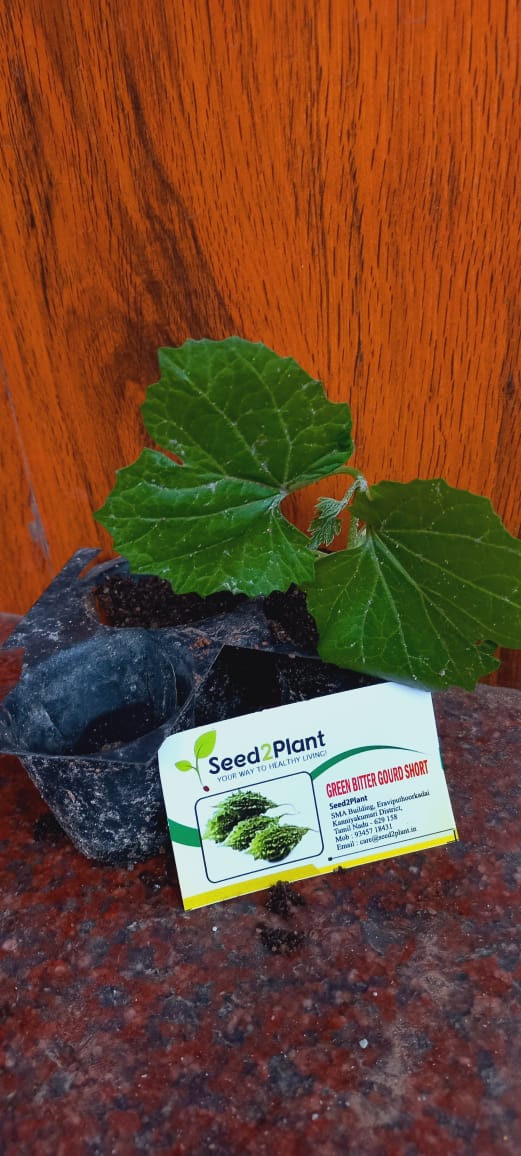


Product Description - Organic Green Bitter Gourd Seeds - Open Pollinated
Bitter gourd seeds have the highest nutritional value and are a healthy source of carbohydrates, proteins, vitamins, and minerals. For medicinal purposes, the fruit and seeds are used. People use bitter gourd as a remedy for Type 1 diabetes, to lose weight, for obesity, and digestive issues, as well as other health problems. Place bitter gourd seeds in the garden in an acidic, well-drained soil in the range of 5.5 to 6.7 and grow them in a soil rich in compost, preferably.
Start transplants earlier than 15 days after seeding or when the leaves are showing their first true signs of life. Growth will be hampered and loss will be high if transplanting is postponed.
Benefits/uses of green bitter gourd
- Vitamin C, an essential micronutrient involved in disease prevention, bone formation, and wound healing, is particularly abundant in bitter gourd.
- It is rich in Vitamin A, which benefits skin health, and other vision conditions, and has other beneficial uses, fat-soluble vitamins as well.
- It supplies folic acid, which is absolutely vital for growth and development as well as lesser quantities of zinc and iron
- Bitter gourd is also high in catechin, gallic acid, epicatechin, and chlorogenic acid, all of which are strong antioxidants that can help protect your cells to stay healthy.
- Native communities around the world use bitter gourd for diabetes related problems for generations
- According to research, there are several compounds in the bitter gourd that may have anticancer properties.
Specifications of bitter gourd seeds
|
Common Name |
Bitter gourd, bitter melon |
|
Sunlight |
6 hours of full sun each day |
|
Water |
Regular water is essential |
|
Temperature |
75 and 80°F (24-31°C) |
|
Soil |
Sandy- or silty-loam soil but good drainage is essential. |
|
Fertilizer |
Slow release organic fertilizer |
|
Germination |
10 to 15 days. |
|
Harvest Season |
55-60 days from seed sowing. |
| No. of Seeds | 11 |
Planting and care for bitter gourd
Sowing bitter gourd seeds
-
Bitter gourd seeds usually have a red coating wrapped around them. The first step is to chip away some of the coating.
-
Soak the seeds in water overnight. The germination process begins with this kick so that seeds can consume large amounts of water immediately.
-
Plant the seeds in the compost about 1 cm deep. In order to nurture the plant, water the pot thoroughly while avoiding a soggy or water-soaked environment which could hinder its growth
-
After a few weeks, you should see the seeds begin to sprout.
Growing bitter gourd
- Use a HDPE Round Grow Bag of 18x18 Inches preferably to place the sprouts.
- A good quality organic potting mixture should be added to the container.
- Creeper nets support hanging fruit, which helps to grow it long and straight.
- Use materials that prevent water from evaporating, including straw, which helps keep the soil moist.
Harvesting bitter gourd
- Bitter gourd should be harvested 12 to 16 weeks after planting and 8 to 10 days after blossoming. Harvest when the fruits are 4 to 6 inches (10-15 cm) long.
- The fruits would be pear-shaped and have light green skin with yellow stripes.
Precautions while growing bitter gourd
- Bittergourd climber necessitates the use of a trellis or a creeper net for support.
- It is recommended that the plant be grown in direct sunlight.
- This climber demands a lot of water, which is why it thrives during the monsoon season.
- Plants are more vulnerable to damage from powdery mildew when they are young, so you can use fungicides like Trichoderma Viride Bio Fertilizer to protect them.
- All gourds require at least 100 frost-free days to develop.
- Plant gourds once the soil temperature has reached 70° to 80°F.
- Start seeds indoors 2 to 4 weeks before transplanting into the garden to get a head start on the season.
Common Problems affecting bitter gourd plants and solutions
The undersides of the leaves curl inward, becoming deformed and yellowish. Aphids are small, oval, and generally green in color and can be found on the underside of leaves. They leave behind an adhesive, blackish scum excrement called honeydew, which can become scummy mold. Consider using insecticidal soap, organic neem cake, or Pseudomonas Fluorescens Biofertilizer as a solution. Adding an organic amendment to a planting bed will help to promote good drainage. The key for long-term plant survival is to ensure moist, but well-drained soil. Do not over-water the plant roots.
No. of Green Bitter Gourd Seeds - 11











